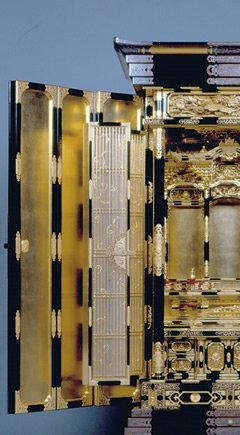SANJO Butsudan (Household Buddhist Altars)

Sanjo has always been strongly associated with Buddhism, and has even been called the “capital” of the faith. Indeed, the finest piece of temple architecture in the Hokuriku region was built here in the 18th century under the direction of the head temple in Kyoto. At that time, many skilled carpenters, cabinet makers and other craftsmen traveled from Kyoto to assist with the construction, passing their skills to many local craftsmen who were also involved. As the numbers of believers in Shin Buddhism increased in the area, so too did the demand for household altars, leading to the establishment of a production center that still stands today.
The inner sanctuary of the altar is a faithful recreation of actual temple architecture, and the fine lacquer work, gilding and superb fittings illustrate why these pieces have such a well-established reputation for quality.
Feature
Sanjo household altars feature a conventional kuden palace that closely adheres to the architecture of actual Buddhist temples. With their refined lacquering, gold leaf and exquisite gold finishings, these pieces have a long-established reputation for superb quality.
How to make
First, the base is assembled using mortise and tenon joining, and the wooden sculptured decorations are carved. Next, the base is temporarily assembled and then disassembled so that each piece can be coated and lacquered. After the pieces have dried, gold dust and gold leaf decorations are applied, maki-e designs are painted and gold finishings are attached. Finally, the altar is reassembled.

